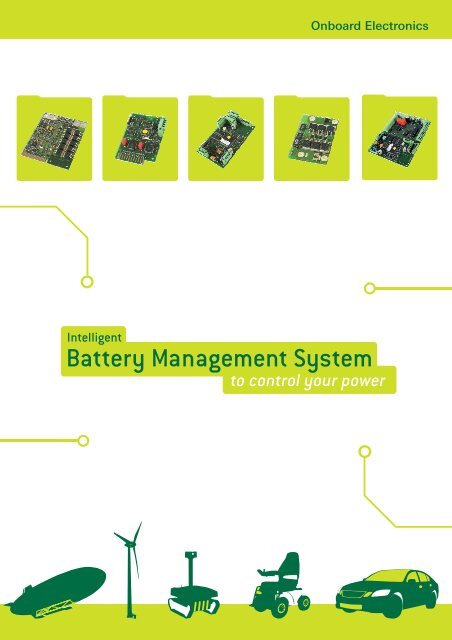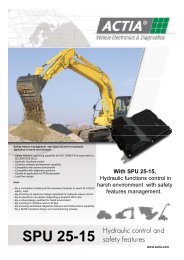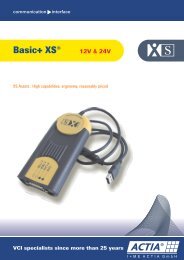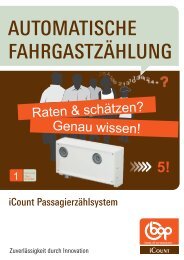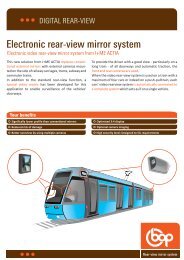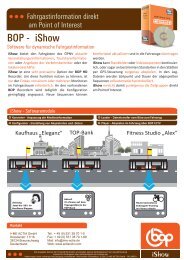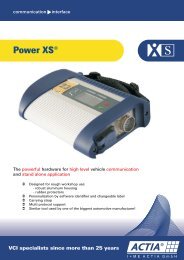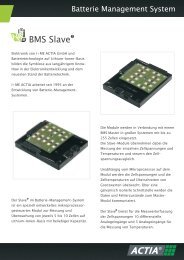Onboard Electronics - I+ME ACTIA GmbH
Onboard Electronics - I+ME ACTIA GmbH
Onboard Electronics - I+ME ACTIA GmbH
You also want an ePaper? Increase the reach of your titles
YUMPU automatically turns print PDFs into web optimized ePapers that Google loves.
<strong>Onboard</strong> <strong>Electronics</strong>
A long- lived Experience<br />
Our Know-How<br />
<strong>I+ME</strong> <strong>ACTIA</strong> has been following since many years new battery technology based on Ni- Mh and Li- Polymer technology. Together<br />
with its long- lived know how in <strong>Electronics</strong> we have been working and developing consequently since 1995 new battery<br />
management systems enabling the use of NiMH or Li- Polymer batteries for mobile applications.<br />
Together with development partners such as VARTA, GAIA, and ZSW, we build up innovative solutions, which have been already<br />
implemented in different applications:<br />
BMS - Mini (7 Cells)<br />
Features<br />
Battery Management System<br />
Enclosure & Housing<br />
Battery Cells Controller<br />
Safety Switch<br />
System Interface<br />
BMS - Master BMS - Slave<br />
BMS - MOSFET<br />
BMS - Monitoring SW<br />
The implementation of our Battery Management Systems gives you competitive advantages:<br />
� By enhancing the battery life<br />
� By enabling the system integration of the battery<br />
� By optimising the charging of batteries through automatic cell balancing<br />
� By reaching high flexibility of use of various numbers of battery cells<br />
� By getting information about the battery, single cells or cell groups<br />
� By ensuring a high security of cells and users through control of the limit values<br />
� By adapting the charging and discharging cycles to the customer and application needs<br />
� By revealing statistics about the battery, such as State of Charge or State of Health, and with it enabling the use in commercial<br />
applications<br />
� By offering minimal power consumption of the BMS thank our automotive electronic know how.
Battery Management Systems: Advantages<br />
Uses<br />
The advantages of the new battery cells can be enhanced<br />
through optimised Battery Management Systems, for<br />
example by avoiding the drifting of the cell voltages through<br />
an active balancing already during the charging.<br />
Our systems are already implemented for NiMH and Lipolymer<br />
batteries.<br />
These systems offer especially for mobile uses such as<br />
hybrid vehicles, bicycles, fork lifts, wheel chairs and robots<br />
the crucial advantage that they control the charging of the<br />
battery through the software application. This can be<br />
furthermore designed so that it supports also the reversal<br />
handling of onboard electric power train.<br />
This functionality enables a secure function of the whole<br />
system and avoids a premature breakdown of the battery<br />
due to frequent overcharging or deep discharging of the<br />
battery cells.<br />
Techniques +++<br />
� The extremely low power consumption and the sleep<br />
mode are advantageous for the use in mobile application<br />
and vehicles because only few power is requested for<br />
the additional electronic.<br />
�<br />
�<br />
�<br />
�<br />
�<br />
�<br />
�<br />
�<br />
The electronics comply with the strict demands of the<br />
automobile industry.<br />
The CAN interfacing is a serial feature and the software<br />
has been already designed so that an optimised<br />
integration in onboard networks can be realised with<br />
complementary system communication.<br />
Management of power demand is supported by<br />
integrated dynamic power prediction.<br />
Through its modular concept (Master and Slaves<br />
modules), BMS can be easily adapted to different cell<br />
types and cell numbers.<br />
BMS enables short charging cycles. The cell balancing is<br />
executed automatically.<br />
State of Charge and State of Health are standard<br />
information.<br />
BMS can be enhanced with addidional components for<br />
security reasons.<br />
The system integration is flexible because of the low<br />
need of place and the modular system architecture.<br />
The communication of the BMS with complex car systems<br />
is a further crucial advantage in order to indicate for<br />
example the status of the battery to the car or to warn<br />
about critical operating use.<br />
�<br />
�<br />
The best price/performance value of these products<br />
enables their integration in application with high<br />
quantities.<br />
Complementary outputs are available for the control of<br />
external components, such as fan or security switches
�<br />
�<br />
�<br />
�<br />
�<br />
�<br />
�<br />
�<br />
�<br />
BMS consist of one Master and up to 20 Slaves (correspond to approx. 15V - 840V)<br />
Applicable for a supply voltage of approx. 7- 42V<br />
Detailed Measurements of voltage with 16 Bit ADC and cell voltage with 12 Bit ADC<br />
Automatic balancing of the cell voltage up to +/- 5mV<br />
Identification of charging and discharging ends with an accuracy of 10mV<br />
Accurate determination of SOC und SOH based on voltage balancing and voltage measurement<br />
as well as other processes<br />
All limit values can be set up as parameters<br />
Communication with the vehicle computer per CAN with extensive messages of faults and<br />
warning<br />
PC Programm for displaying and analysing per CAN or RS232<br />
Master Function Slave Function<br />
�<br />
�<br />
�<br />
�<br />
�<br />
�<br />
Technical Data<br />
CAN<br />
Interface<br />
RS232<br />
Interface<br />
Voltage measurement for the whole battery<br />
Data exchange with the slave modules<br />
System surveillance and triggering of the<br />
protective relay<br />
Triggering of fan or other components which are<br />
necessary for the operation of big batteries<br />
Administartion of system information auch as<br />
SOC, SOH, Date and time<br />
Communication to external peripherics through<br />
CAN<br />
<strong>I+ME</strong> <strong>ACTIA</strong> <strong>GmbH</strong><br />
System Supply<br />
KL30, KL31, KL15<br />
BCS- MASTER<br />
16 Bit Microcontroller<br />
1 MB SRAM<br />
512 KB Flash<br />
8 KB EEPROM<br />
Current<br />
Measuring<br />
Interface<br />
Relay and<br />
Switch Outputs<br />
�<br />
�<br />
�<br />
�<br />
isolated serial<br />
communication<br />
<strong>I+ME</strong> <strong>ACTIA</strong><br />
Informatik und Mikro- Elektronik <strong>GmbH</strong><br />
Dresdenstr. 17/18<br />
D- 38124 Braunschweig<br />
connections to up to 10<br />
cells of battery<br />
BCS- SLAVE<br />
8 Bit<br />
Microcontroller<br />
intern RAM<br />
4 KB Flash<br />
8 KB EEPROM<br />
Temperature Control<br />
Safety Control<br />
Isolation Control<br />
Measurement of the cell voltage<br />
Balancing of different cell voltages<br />
Measurement of temperature<br />
Communication with the Master<br />
Tel: ++49 (0) 531 38701- 0<br />
Fax: ++49 (0) 531 38701- 88<br />
Email: info@ime- actia.de<br />
Web: www.ime- actia.com<br />
BMS - Mini (7 cells)<br />
BMS - Application Board<br />
BMS - Master<br />
BMS - Slave<br />
BMS - MOSFET<br />
BMS - Standalone Slave<br />
This Product Information Sheet is offered without charge to the customers of <strong>I+ME</strong> <strong>ACTIA</strong> <strong>GmbH</strong>. Data is the most current known to <strong>I+ME</strong> <strong>ACTIA</strong> <strong>GmbH</strong> at the<br />
time of preparation and is believed to be accurate. It should not be construed as guaranteeing specific properties of the products as described or suitability for a<br />
particular application. All Information are suitable for modification. © 2009 <strong>I+ME</strong> <strong>ACTIA</strong> <strong>GmbH</strong> IR11652C


